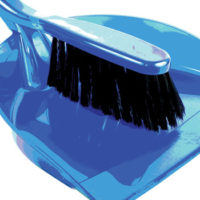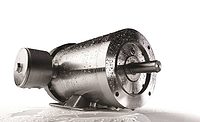Deep Cleaning – A Specialized Cleaning Process
An effective sanitation program is key to controlling food safety issues such as Listeria monocytogenes and Salmonella and maintaining product shelf life. The type and frequency of cleaning depends on the complexity of the process, equipment design, and types of soils involved. This program includes both a regular cleaning program which is every 24 hours for most processes, and on a less frequent basis, specialized cleaning procedures, such as deep cleaning, are necessary for equipment and the environment. Deep cleaning is an intensified cleaning procedure that involves the extensive disassembly of all equipment to allow the cleaning of harborage and niche areas and components of equipment, getting deep into cracks, crevices and pores that are difficult to reach during the normal, daily sanitation process. These are the areas where food residues and fines from foods, liquids from marinades, pin feathers and fish scales can become trapped inside equipment and the only way to clean is to access their hiding places. A thorough breakdown of equipment can be time consuming and labor intensive and requires the coordinated efforts of production, maintenance, engineering, sanitation, quality and food safety. Some outside expertise such as a sanitation specialist, refrigeration, and your chemical representative may also be of value. Due to the extensive nature of the breakdown, deep cleaning often occurs when there is a holiday or a planned production down day. All conveyors, belts, rollers, sprockets, shaft drives, turn drives, cogs, wear strips, guides, tables, sorters, packaging machines, scarpers on the ends of belts and entrances and exits to cookers and freezers must be broken down to the frame paying particular attention to where niche areas may be in and around equipment. This includes all equipment such as freezers, fryers, cookers, steamers, battering equipment, slicers, dicers, chillers and packaging equipment as well as any part that can be removed including gaskets, guards, o-rings, seals, slicer blades, grinding plates, blades, auger, doors, blender blade and shaft. The breakdown also includes items such as chain guards, electrical panels, control panels, motor covers, floor scales, doors and overheads such as cooling units, drip pans, exhaust ducts, fans, lights, ceilings and walls that are sometimes overlooked during normal sanitation. Be sure to review the proper breakdown of refrigeration units with engineering or with a refrigeration specialist before proceeding. Remember to cover water-sensitive equipment and electrical components before rinsing. However, these sensitive areas must also be cleaned using the appropriate chemicals.
The breakdown process may lead to a breakdown of unexplored areas of equipment so having maintenance on hand to assist in the breakdown is invaluable. The process can also lead to opportunities to redesign parts to be more easily removed and cleaned in the future. Be sure to keep track of parts such as screws, bolts, hoses, wear strips and guides for equipment such as conveyors. These parts can be placed in tubs and labeled with the equipment or conveyor number on it to keep track of conveyor belts and associated guides, parts and pieces. A map of the room and lines with a number or color code can also assist in keeping track of parts and pieces. Following removal, conveyor belts can be put into vats for scrubbing or laid out on plastic sheeting covering the floor to access all areas for scrubbing and cleaning as long as attention is paid to controlling cross contamination from the floor and equipment to the belting during the cleaning and sanitation process. Following the equipment breakdown, equipment surfaces, framework, and the environment (non-food contact surfaces) must be cleaned thoroughly, including adequate dry pick up, rinsing of equipment, correct chemical concentration and complete coverage and scrubbing of all equipment surfaces. Scrubbing is necessary to remove residues and biofilm build up that are not visible to the human eye and are too often neglected due to the time-consuming and labor-intensive nature of the task. Too often sanitation crews chase food particles across the floor with a hose or spray equipment that is already visibly clean instead of using valuable time applying the mechanical action so critical to the cleaning process. Nonfood contact areas, such as walls, floors, undersides of equipment and tables and equipment frames, must be scrubbed as well as food contact surfaces as these surfaces are just as important as product contact surfaces. In order to achieve this, the same emphasis on cleaning and sanitation must be placed on these too often neglected surfaces as it is on product contact surfaces.
Following application of cleaner, scrubbing and rinsing, a sanitizer is applied to equipment surfaces. Following cleaning and scrubbing, some items such as belts and floor mats may also be soaked overnight in sanitizer. During the assembly of equipment, caution must be taken to avoid recontamination of equipment by employees, tools, lifts and ladders. When all the equipment is up and running, a final sanitizer is applied and the equipment and intensive breakdown can be added to a master sanitation schedule. If a facility has had problems in their ready-to-eat or even in raw areas, supplementing the cleaning process with an additional cleaning step that includes a strong oxidizer such as a hydrogen peroxide-based cleaning chemical can help to reduce microbiological issues related to food safety and shelf life. Incorporating a specialized cleaning process, such as deep cleaning, into a sanitation program will improve your overall sanitation program, and go a long way in protecting your brand, and ensuring product quality and food safety.
Margaret D. Hardin, Ph.D., is vice president of technical services at IEH Laboratories and Consulting Group. She is a member of the Editorial Board for Food Safety Magazine, the International Journal of Food Microbiology and the Journal of Food Protection. She has served as a member of the National Advisory Committee on Microbiological Criteria for Foods and the National Advisory Committee for Meat and Poultry Inspection.
Looking for a reprint of this article?
From high-res PDFs to custom plaques, order your copy today!








